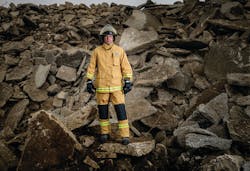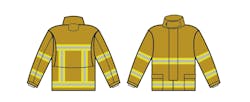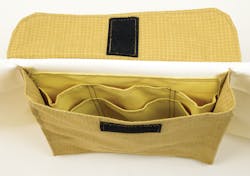I am a man of many duties: a career line firefighter, a PPE committee member, a volunteer officer who manages budget items and a product salesperson. As such, I have been privy to the numerous ways that departments reach their final purchasing goals. These include instances in which the fire chief made the decision without the involvement of anyone else. I also witnessed committees that comprise multiple levels in an organizational totem pole help to drive these determinations.
Typically, the idea of adding new PPE to the department arsenal stems from an emergency run or training evolution. Discussions follow: “Do you believe that the administration will approve an alternative PPE option? What type should we get?
Who should we buy it from? Is this something that our personnel would wear?”
In many places throughout the United States, structural turnout gear is used as the primary garment of choice for all response types, but is this philosophy the best thing for members? Certainly, wearing structural turnout gear for all runs is advantageous from a purchasing standpoint, but at what cost? Additional fatigue to the end user? Increased opportunity for damage to the gear when it isn’t used for its primary purpose?
NFPA says that structural turnout gear can be used for 10 years and then must be retired. If members use this gear for technical rescue and/or wildland applications as well as for structural fires, it’s reasonable to expect additional damage. The downtime that’s needed to complete the necessary repairs reduces the overall life of the gear as intended.
Navigating the process of specifying and purchasing technical rescue gear can be a daunting task. It takes dedicated members who are willing to put in the time. They must have a solid understanding of the needs of their department as well as a schedule that permits them to research the manufacturers, materials and options, all while staying within budget.
PPE selection committee members must seek out other end users to gather feedback. End users’ firsthand knowledge on how gear performs can help to narrow down choices.
PPE salespeople who put the department’s mission ahead of the sale are key, too. They are in a better position to help to guide the process of purchasing rescue gear.
Once the decision is made to purchase alternative PPE, the real work starts.
PPE must meet the needs of both the end user and the administration. The administration values longevity and cost, for example. The end user values comfort and options, which go hand in hand with reducing fatigue and the ability to better perform the necessary tasks.
The person who serves as the “budget keeper” must work to ensure that the best equipment is delivered to those who provide the service and that the equipment meets the needs of the people who the members serve.
Single-use vs. multi-use
The first step in finding the right protective ensemble for a department is defining the primary needs of the PPE. This helps to narrow down one’s choice of manufacturer.
Manufacturers of alternative PPE typically have single- and dual-purpose garment options in their product lineup.
EMS response agencies and wildland fire teams might choose a set of garments that only holds one certification in the NFPA standards. For example, EMS departments might focus on color, comfort and bloodborne pathogen-resistance. A hotshot crew’s needs lean more toward a reduction in fatigue with a higher flash protection.
If your agency travels down many avenues of response types, an alternative protective garment set that’s certified in more than one area per NFPA should be considered. If this is the case, you nevertheless must determine what the primary use or desired goal is for the purchase of the additional garments.
The garments
Multiple manufacturers of structural firefighting gear have made alternative PPE options for a long time; some other manufacturers are newer to the game.
The material choices for these garments are fairly standard; however, some manufacturers offer additional options. Defender M from TenCate, Sigma from Safety Components and Nomex from DuPont are the most common material choices. Fire-Dex offers TECGEN51 as an exclusive alternative material.
Manufacturers’ alternative PPE options tend to start on very similar platforms.
That said, you will find that trousers that serve as a stand-alone pant or an overgarment have few to no options. Belt loops on the pants might be the most prominent.
Coats might have a radio pocket and/or two small pockets available optionally.
One might believe that when department representatives first meet with alternative PPE suppliers their first question, by and large, is about which materials to select. From the work that I do in assisting such folks, I have found that typically isn’t true. The first question typically is “What colors do they come in?” or “Can we customize?” or “Is the sizing general or custom?”
The reasoning behind the consideration of color and customization options might be most mission-critical in terms of differentiating between crews that are on scene. Some departments choose a different color just so that the wrong set isn’t donned while turning out.
Alternative PPE comes in a small array of materials with a few color options. Single-purpose wildland gear might get a lighter-colored material in consideration of the constant sunlight that’s encountered while fighting wildfires. EMS gear typically is specced in navy as a means of visibly distinguishing those members from firefighting personnel. Multi-use gear colors, such as light gold, black and tan, are the most common.
Trim
Once type of gear, materials and colors are nailed down, trim packages commonly are next. Some manufacturers offer their gear as designed, while others give the option to upgrade at every turn.
In these days of the distracted driver, high-visibility trim isn’t a place in which to skimp. 3M Scotchlite trim is being put on most of the NFPA garments at the most basic level but often is upgraded.If your gear will be used for automobile extrication, I highly recommend an upgrade in this area. The New York-style high-visibility option has two rings of Scotchlite on the coat: one at the wrist and one at the upper arm level, which carries over onto the chest of the garment. In addition, the high-visibility option adds two verticals up the backside of the coat, which connects the two rings.
The traditional solid trim panels of single-color orange/lime or triple trim, with the silver stripe between the colors, are a slightly more cumbersome option but hold up better to abuse than their vented or spaced out comfort trim counterparts do.
A vertical stripe on the pant leg is a nice option for added visibility.
Knees and pockets
The two items that are most discussed on trousers are the knees and the pockets.
Most trousers come with reinforced knees. Typically, the basic option is just a second layer of the chosen material, but it almost always is selected for an upgrade. You can specify additional padding as well as leather or Kevlar on top of the padding.
I have found that an exceptional upgrade in this area is the Diamond Flex option by Veridian Fire Protection Gear. It adds multilayer padding with a Kevlar overlay. This is stitched in small diamond formations for added comfort and flexibility for when members work on their knees.Pockets typically are on the side legs. Some manufactures have rear hip pockets.
If the gear that you choose has pocket options, lean toward a split pocket or one that has internal tool dividers. This contribution to proper tool placement can help with comfort and organization.
Black Kevlar-wrapped outer pockets are a relatively inexpensive option that adds more durability to a heavily worn area of the pants than is provided at the base level.
Depending on the alternative PPE manufacturer, additional options include a standard waist band, an elastic waistband, suspenders, zippered leg expansion, reinforced D-rings or accessory clips, an internal harness and external harness loops for Class 3 harnesses.
Coats
The coats that are in these ensembles have a multitude of standard and upgradable options. They typically come standard with a FlexWing back for added mobility and comfort. The same can be said for radio pockets, mic tabs, flashlight holders, take-up straps around the wrist and handwarmer/bellow pockets.
Fire-Dex, Lion and Viking, among other manufacturers, offer snap-in moisture-barrier liners that provide bloodborne pathogen-resistance.
A fleece liner for additional thermal protection that can be used for operations in cold-weather climates is another option that’s offered by several manufacturers.
A few Lion PPE options have a detachable hood for inclement weather.
Kevlar-reinforced elbows is an option that adds increased comfort and durability to a well-known wear point.
The radio pocket should be test-fitted during the product demonstration to ensure that the portable fits and is in a desired location.
Kevlar reinforcements on both the coat and pants, whether it be pockets, knees, cuffs or accessory points, always are an option that are worthy of consideration. The upfront cost is minimal and, generally, incurs less expense than the shipping bill for sending a set of gear to a service for it to get repaired.
End goal
If you are involved with the process of purchasing alternative PPE, you should strive to make everyone happy. That said, that’s almost never attainable. Nevertheless, as you follow the path to build the perfect set of alternative PPE for your department’s members, listen to the desires of those members. It is they who will wear the gear. At the same time, you must respect the budget that’s set forth by department administration, because that will mean that they already are behind you to make the purchase.
Ensuring the Best Fit
Gear sizing is something that’s totally dependent on manufacturer. Some gear comes in a S–XXXL; others are tailored specifically to the wearer. The latter is something to consider if your budget allows for every end user to have a set.
Maintenance & Storage
The maintenance that’s required for alternative PPE is fairly similar to that for structural turnout gear. Some precleaning or rinsing along with a balanced detergent in the extractor will do the job.
As is the case with structural gear, if you get some form of chemical contaminant on alternative PPE, you should contact a commercial gear cleaning service for cleaning, treatment and inspection for damage.
Alternative PPE should be stored according to manufacturer recommendation.
The logistics of adding more PPE to a department’s assets certainly incurs more work. Tracking this gear can be made easier by adding identification to each garment via removable ID plates. Adding another person to your PPE oversight also might be a good idea to help to reduce the workload of tracking, inspecting, etc.
About the Author

Patrick Redd
Patrick Redd is a 17-year veteran of the fire service. He currently is a firefighter/paramedic at the Violet Township Fire Department in Pickerington, OH, where he sits on the technical rescue committee. Redd also serves as a captain for the Walnut Township Fire Department in Millersport, where he oversees all PPE and heads the hiring and technical rescue committees. He holds certifications as an Ohio Firefighter 2, paramedic, rescue technician, fire instructor and public safety diver. Redd is a member of the Central Ohio Strike Team and a supervisor for the Fairfield County Special Operations Team water rescue team. He is the co-owner of Redd Public Safety Equipment and manages all aspects of PPE and technical rescue equipment sales and training.


